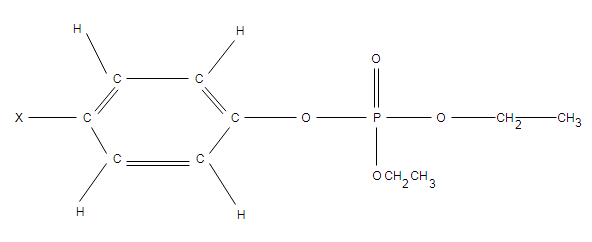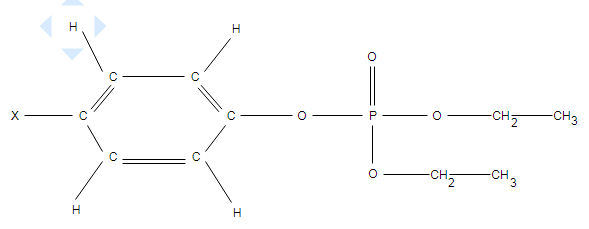
Chemistry, Books a la Carte Edition and Modified Mastering Chemistry with Pearson eText & ValuePack Access Card (7th Edition)
7th Edition
ISBN: 9780134172514
Author: John E. McMurry
Publisher: PEARSON
expand_more
expand_more
format_list_bulleted
Concept explainers
Question
Chapter 7, Problem 7.24P
(a)
Interpretation Introduction
To determine:
 Which chemical group
Which chemical group
(b)
Interpretation Introduction
To determine:
 Which chemical group at position X would result in greatest toxicity.
Which chemical group at position X would result in greatest toxicity.
Expert Solution & Answer
Want to see the full answer?
Check out a sample textbook solution
Students have asked these similar questions
Draw the structure of A, the minor E1 product of the reaction.
Cl
Skip Part
Check
F1
esc
CH_CH OH, D
3 2
Click and drag to start drawing a
structure.
80
R3
F4
F2
F3
@
2
#
$
4
3
Q
W
95
%
KO
5
F6
A
F7
×
G
☐
Save For Later
Sub
2025 McGraw Hill LLC. All Rights Reserved. Terms of Use | Privacy C
►II
A
A
F8
F9
F10
FL
6
7
88
&
*
8
9
LLI
E
R
T
Y
U
A
S
D
lock
LL
F
G
H
0
P
J
K
L
Z
X
C
V B
N
M
9
H
From the choices given, which two substances have the same crystal structure? (Select both)
Group of answer choices
ZnS (zincblende)
Diamond
TiO2 (rutile)
ZnS (wurtzite)
Potassium (K) blends with germanium (Ge) to form a Zintl phase with a chemical formula of K4Ge4. Which of the following elements would you expect potassium to blend with to form an alloy?
Electronegativities: As (2.0), Cl (3.0), Ge (1.8), K (0.8), S (2.5), Ti (1.5)
Group of answer choices
Arsenic (As)
Sulfur (S)
Chlorine (Cl)
Titanium (Ti)
Chapter 7 Solutions
Chemistry, Books a la Carte Edition and Modified Mastering Chemistry with Pearson eText & ValuePack Access Card (7th Edition)
Ch. 7 - Prob. 7.1PCh. 7 - Conceptual APPLY 7.2 An electrostatic potential...Ch. 7 - Prob. 7.3PCh. 7 - Prob. 7.4ACh. 7 - Prob. 7.5PCh. 7 - Prob. 7.6ACh. 7 - Prob. 7.7PCh. 7 - Prob. 7.8ACh. 7 - Prob. 7.9PCh. 7 - Prob. 7.10A
Ch. 7 - Prob. 7.11PCh. 7 - Prob. 7.12ACh. 7 - Prob. 7.13PCh. 7 - Prob. 7.14ACh. 7 - Prob. 7.15PCh. 7 - Prob. 7.16ACh. 7 - Prob. 7.17PCh. 7 - Prob. 7.18ACh. 7 - Prob. 7.19PCh. 7 - Prob. 7.20ACh. 7 - Prob. 7.21PCh. 7 - Prob. 7.22ACh. 7 - Prob. 7.23PCh. 7 - Prob. 7.24PCh. 7 - Prob. 7.25PCh. 7 - Prob. 7.26PCh. 7 - Prob. 7.27PCh. 7 - Prob. 7.28PCh. 7 - Prob. 7.29CPCh. 7 - Prob. 7.30CPCh. 7 - Prob. 7.31CPCh. 7 - Prob. 7.32CPCh. 7 - Prob. 7.33CPCh. 7 - Prob. 7.34CPCh. 7 - Prob. 7.35CPCh. 7 - Prob. 7.36CPCh. 7 - Prob. 7.37CPCh. 7 - Prob. 7.38CPCh. 7 - Prob. 7.39CPCh. 7 - Prob. 7.40CPCh. 7 - Prob. 7.41CPCh. 7 - Prob. 7.42CPCh. 7 - Prob. 7.43CPCh. 7 - Prob. 7.44CPCh. 7 - Prob. 7.45CPCh. 7 - Prob. 7.46CPCh. 7 - Prob. 7.47CPCh. 7 - Prob. 7.48CPCh. 7 - Which of the substances...Ch. 7 - Prob. 7.50CPCh. 7 - Order the following compounds according to the...Ch. 7 - Prob. 7.52CPCh. 7 - Prob. 7.53CPCh. 7 - Prob. 7.54CPCh. 7 - Prob. 7.55CPCh. 7 - Explain the difference in the bond dissociation...Ch. 7 - Explain the difference in the bond dissociation...Ch. 7 - Prob. 7.58CPCh. 7 - Prob. 7.59CPCh. 7 - Prob. 7.60CPCh. 7 - Prob. 7.61CPCh. 7 - Prob. 7.62CPCh. 7 - Prob. 7.63CPCh. 7 - Prob. 7.64CPCh. 7 - Prob. 7.65CPCh. 7 - Prob. 7.66CPCh. 7 - Prob. 7.67CPCh. 7 - Prob. 7.68CPCh. 7 - Prob. 7.69CPCh. 7 - Prob. 7.70CPCh. 7 - Prob. 7.71CPCh. 7 - Identify the third-row elements, X, that form the...Ch. 7 - Identify the fourth-row elements, X, that form the...Ch. 7 - Prob. 7.74CPCh. 7 - Prob. 7.75CPCh. 7 - Methyiphenidat (C14H19NO2) , marketed as Ritalin,...Ch. 7 - Prob. 7.77CPCh. 7 - Prob. 7.78CPCh. 7 - Prob. 7.79CPCh. 7 - Prob. 7.80CPCh. 7 - Prob. 7.81CPCh. 7 - Prob. 7.82CPCh. 7 - Prob. 7.83CPCh. 7 - Prob. 7.84CPCh. 7 - Prob. 7.85CPCh. 7 - Prob. 7.86CPCh. 7 - Prob. 7.87CPCh. 7 - Prob. 7.88CPCh. 7 - Prob. 7.89CPCh. 7 - Prob. 7.90CPCh. 7 - Draw two electron-dot resonance structures that...Ch. 7 - Prob. 7.92CPCh. 7 - Prob. 7.93CPCh. 7 - Prob. 7.94CPCh. 7 - Prob. 7.95CPCh. 7 - Prob. 7.96CPCh. 7 - Prob. 7.97CPCh. 7 - Prob. 7.98CPCh. 7 - Prob. 7.99CPCh. 7 - Write an electron-dot structure for chloral...Ch. 7 - Prob. 7.101CPCh. 7 - Prob. 7.102CPCh. 7 - Prob. 7.103CPCh. 7 - Prob. 7.104CPCh. 7 - Prob. 7.105CPCh. 7 - 7.106 Themolecule has nitrogen-oxygen bonds, but...Ch. 7 - Prob. 7.107CPCh. 7 - Prob. 7.108MPCh. 7 - Prob. 7.109MPCh. 7 - Prob. 7.110MPCh. 7 - Prob. 7.111MPCh. 7 - Prob. 7.112MP
Knowledge Booster
Learn more about
Need a deep-dive on the concept behind this application? Look no further. Learn more about this topic, chemistry and related others by exploring similar questions and additional content below.Similar questions
- Consider two elements, X and Z. Both have cubic-based unit cells with the same edge lengths. X has a bcc unit cell while Z has a fcc unit cell. Which of the following statements is TRUE? Group of answer choices Z has a larger density than X X has more particles in its unit cell than Z does X has a larger density than Z Z has a larger unit cell volume than Xarrow_forwardHow many particles does a face-centered cubic (fcc) unit cell contain? Group of answer choices 2 14 8 4arrow_forwardV Highlight all of the carbon atoms that have at least one beta (B) hydrogen, using red for one ẞ hydrogen, blue for two ẞ hydrogens, and green for three ẞ hydrogens. If none of the carbon atoms have ẞ hydrogens, check the box underneath the molecule. ED X None of the carbon atoms have ẞ hydrogens. Explanation esc 2 Check * F1 F2 1 2 80 # 3 Q W tab A caps lock shift fn control F3 N S option O 694 $ F4 F5 F6 005 % E R D F LL 6 olo 18 Ar B © 2025 McGraw Hill LLC. All Rights Reserved. Terms of Use | Privacy Center | Accessibility A DII F7 F8 87 & * 8 T Y U G H 4 F9 F10 ( 9 0 E F11 F12 உ J K L + || X C V B N M H H command option commandarrow_forward
- Consider the reaction below and answer the following questions. Part 1 of 4 Br NaOCH2CH3 Identify the mechanisms involved. Check all that apply. SN 1 SN 2 E1 E2 None of the above Part 2 of 4 Skip Part Check esc F1 F2 lock 1 2 Q W A S #3 80 F3 F4 F5 F6 Save For © 2025 McGraw Hill LLC. All Rights Reserved. Terms ˇˇ % & 4 5 6 89 7 IK A 分 བ F7 F8 F9 F * E R T Y U 8 9 D F G H K V B N M 0 Oarrow_forwardWhat kind of holes are not generated when solid-state particles adopt a close packing pattern? Group of answer choices tetrahedral cubic octahedral None of the other choices are correctarrow_forwardFor the reaction below: 1. Draw all reasonable elimination products to the right of the arrow. 2. In the box below the reaction, redraw any product you expect to be a major product. 田 Major Product: Check ☐ + I Na OH esc F1 F2 2 1 @ 2 Q W tab A caps lock S #3 80 F3 69 4 σ F4 % 95 S Click and drag to sta drawing a structure mm Save For Later 2025 McGraw Hill LLC. All Rights Reserved. Terms of Use GO DII F5 F6 F7 F8 F9 F10 6 CO 89 & 7 LU E R T Y U 8* 9 0 D F G H J K L Z X C V B N M 36arrow_forward
- Problem 7 of 10 Draw the major product of this reaction. Ignore inorganic byproducts. S' S 1. BuLi 2. ethylene oxide (C2H4O) Select to Draw a Submitarrow_forwardFeedback (4/10) 30% Retry Curved arrows are used to illustrate the flow of electrons. Use the reaction conditions provided and follow the arrows to draw the reactant and missing intermediates involved in this reaction. Include all lone pairs and charges as appropriate. Ignore inorganic byproducts. Incorrect, 6 attempts remaining :0: Draw the Reactant H H3CO H- HIO: Ö-CH3 CH3OH2* protonation H. a H (+) H Ο CH3OH2 O: H3C protonation CH3OH deprotonation > CH3OH nucleophilic addition H. HO 0:0 Draw Intermediate a Xarrow_forwardCan I please get the blank spaces answered/answers?arrow_forward
- 1. Identify the following alkenes as E or Z NH₂ Br 2. Draw the structures based on the IUPAC names (3R,4R)-3-bromo-4-fluoro- 1-hexene (Z)-4-bromo-2-iodo-3-ethyl- 3-heptene تر 3. For the following, predict all possible elimination product(s) and circle the major product. HO H₂SO4 Heat 80 F4 OH H2SO4 Heat 어요 F5 F6 1 A DII 4 F7 F8 F9 % & 5 6 7 * ∞ 8 BAB 3 E R T Y U 9 F D G H J K O A F11 F10arrow_forwardDraw the major product of this reaction. Ignore inorganic byproducts. ○ O 1. H₂O, pyridine 2. neutralizing work-up a N W X 人 Parrow_forward✓ Check the box under each molecule that has a total of five ẞ hydrogens. If none of the molecules fit this description, check the box underneath the table. tab OH CI 0 Br xx Br None of these molecules have a total of five ẞ hydrogens. esc Explanation Check caps lock shift 1 fn control 02 F2 W Q A N #3 S 80 F3 E $ t 01 205 % 5 F5 & 7 © 2025 McGraw Hill LLC. All Rights Reserved. Terms of Use | Privacy Center | Accessibility FT * 8 R T Y U כ F6 9 FIG F11 F D G H J K L C X V B < N M H option command P H + F12 commandarrow_forward
arrow_back_ios
SEE MORE QUESTIONS
arrow_forward_ios
Recommended textbooks for you
 ChemistryChemistryISBN:9781305957404Author:Steven S. Zumdahl, Susan A. Zumdahl, Donald J. DeCostePublisher:Cengage Learning
ChemistryChemistryISBN:9781305957404Author:Steven S. Zumdahl, Susan A. Zumdahl, Donald J. DeCostePublisher:Cengage Learning ChemistryChemistryISBN:9781259911156Author:Raymond Chang Dr., Jason Overby ProfessorPublisher:McGraw-Hill Education
ChemistryChemistryISBN:9781259911156Author:Raymond Chang Dr., Jason Overby ProfessorPublisher:McGraw-Hill Education Principles of Instrumental AnalysisChemistryISBN:9781305577213Author:Douglas A. Skoog, F. James Holler, Stanley R. CrouchPublisher:Cengage Learning
Principles of Instrumental AnalysisChemistryISBN:9781305577213Author:Douglas A. Skoog, F. James Holler, Stanley R. CrouchPublisher:Cengage Learning Organic ChemistryChemistryISBN:9780078021558Author:Janice Gorzynski Smith Dr.Publisher:McGraw-Hill Education
Organic ChemistryChemistryISBN:9780078021558Author:Janice Gorzynski Smith Dr.Publisher:McGraw-Hill Education Chemistry: Principles and ReactionsChemistryISBN:9781305079373Author:William L. Masterton, Cecile N. HurleyPublisher:Cengage Learning
Chemistry: Principles and ReactionsChemistryISBN:9781305079373Author:William L. Masterton, Cecile N. HurleyPublisher:Cengage Learning Elementary Principles of Chemical Processes, Bind...ChemistryISBN:9781118431221Author:Richard M. Felder, Ronald W. Rousseau, Lisa G. BullardPublisher:WILEY
Elementary Principles of Chemical Processes, Bind...ChemistryISBN:9781118431221Author:Richard M. Felder, Ronald W. Rousseau, Lisa G. BullardPublisher:WILEY

Chemistry
Chemistry
ISBN:9781305957404
Author:Steven S. Zumdahl, Susan A. Zumdahl, Donald J. DeCoste
Publisher:Cengage Learning

Chemistry
Chemistry
ISBN:9781259911156
Author:Raymond Chang Dr., Jason Overby Professor
Publisher:McGraw-Hill Education

Principles of Instrumental Analysis
Chemistry
ISBN:9781305577213
Author:Douglas A. Skoog, F. James Holler, Stanley R. Crouch
Publisher:Cengage Learning

Organic Chemistry
Chemistry
ISBN:9780078021558
Author:Janice Gorzynski Smith Dr.
Publisher:McGraw-Hill Education

Chemistry: Principles and Reactions
Chemistry
ISBN:9781305079373
Author:William L. Masterton, Cecile N. Hurley
Publisher:Cengage Learning

Elementary Principles of Chemical Processes, Bind...
Chemistry
ISBN:9781118431221
Author:Richard M. Felder, Ronald W. Rousseau, Lisa G. Bullard
Publisher:WILEY
Stoichiometry - Chemistry for Massive Creatures: Crash Course Chemistry #6; Author: Crash Course;https://www.youtube.com/watch?v=UL1jmJaUkaQ;License: Standard YouTube License, CC-BY
Bonding (Ionic, Covalent & Metallic) - GCSE Chemistry; Author: Science Shorts;https://www.youtube.com/watch?v=p9MA6Od-zBA;License: Standard YouTube License, CC-BY
General Chemistry 1A. Lecture 12. Two Theories of Bonding.; Author: UCI Open;https://www.youtube.com/watch?v=dLTlL9Z1bh0;License: CC-BY